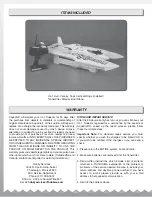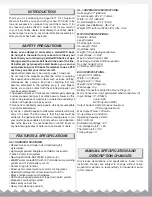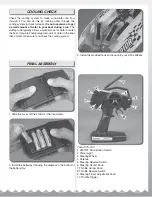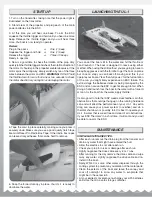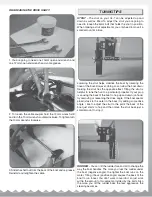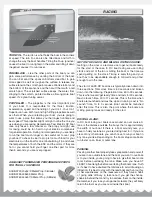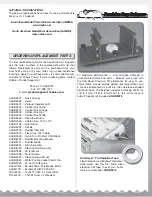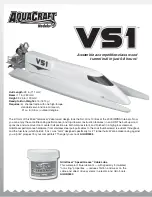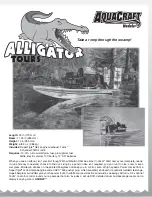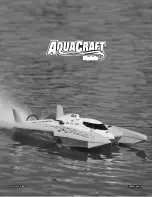
8
TURN FIN
– The turn fi n is what holds the boat in the corners
at speed. The turn fi n can also be tilted back and forth to
change the way the boat handles. Tilting the fi n up (positive)
causes the boat to run tighter on the water and tilting it down
(negative) causes it to run looser.
FIBERGLASS
– Like the other parts of the boat you can
gain some performance by working the bottom of the boat.
You can fl at sand the sponson bottoms dead fl at to gain
more speed as well as roughen the surface to release any
surface tension the smooth paint causes. We like to fl at sand
the bottom of the sponsons and then scuff them with a red
scratch pad. The scratched surface keeps the water from
clinging to the smooth, painted surface, allowing more boat
speed. It’s a great tuning secret.
PROPELLER
– The propeller is the most important part
of your boat. It is responsible for the thrust, traction,
acceleration, speed and handling of your UL-1. Your UL-1
Superior can use both low and high lifting propellers as well
as others. When you are testing your boat, you are going to
want to use a prop that allows you the longest runtime and
best speed. This propeller might or might not be the one you
use when you are racing. Remember a Fast Electric RC boat
race only takes a few minutes so the prop you might use
for racing could be too hard on your electric components
for general operation. During normal operation you are likely
to run the boat much longer so be careful not to over prop
your boat. To check to see if a prop is too much load for your
electronics run the boat for one minute. Bring it in and check
the temperatures of both the ESC and the motor. If they are
hot or you cannot hold your fi nger on either part for more
then 5 seconds, you are over propped.
AQUACRAFT GRIMRACER PERFORMANCE PROPS
FOR THE UL-1 SUPERIOR
AQUB9720 40x52/3 Metal Prop (3-Blade)
AQUB9755 L38x55 Metal Prop
AQUB9760 L40x57/3 Metal Prop (3-Blade)
RACING
GET ON THE CLOCK AND MILLING ON THE COURSE:
Getting on the clock is a term we use to get our boats ready
for the start of the race. In RC boat racing we use rolling
starts and part of the fun is milling the boat, or the time we
spend getting on the clock. Timing is everything and your
boat has to be dependable enough to mill well and go fast
enough to win the race.
The start of an FE RC boat race is typically broken down into
three sections. Total clock time is 60 seconds and broken
down into the following: Preparation time, 60 to 30 seconds.
This is what we call “get ready” time and lasts for 30 seconds.
Next is launch time, 30 to 11 seconds. This is the time when
boats are launched and must be up and running. Last is “No
Launch” time, 10 to 0 seconds. Boat cannot be launched
after this time. This is also the point where the boats are
milling, picking lanes and ready for the start.
DRIVING A LANE:
In RC boat racing our boats race around an oval course. A
lane is the distance outside the buoys that is approximately
the width of our boat. If there is a boat around yours, you
have to hold your lane as you are driving next to it. If you are
clear of any other boats, you can choose to run your boat in
any lane you like. Depending on the boat setup some boats
run faster on an inner or outer lane.
PASSING:
Passing another boat properly takes preparation and power. If
you are in an outside lane and the boat you want to overtake
is to your inside, you’re going to have to give that boat some
room before overtaking the lane. Make sure you have AT
LEAST 3 boat lengths before overtaking that boat’s lane. Truth
is it’s best to have doubled that distance to avoid drawing an
infraction. It is best to stay with the lead boat and hunt out his
or her weaknesses on the racecourse. If they have a habit
of going wide off buoy 6, take note. If you get the chance,
sneak in behind them and try to overtake them on the inside.
Remember, if you race your opponent cleanly, they will likely
return the favor as you are now inside their boat.


